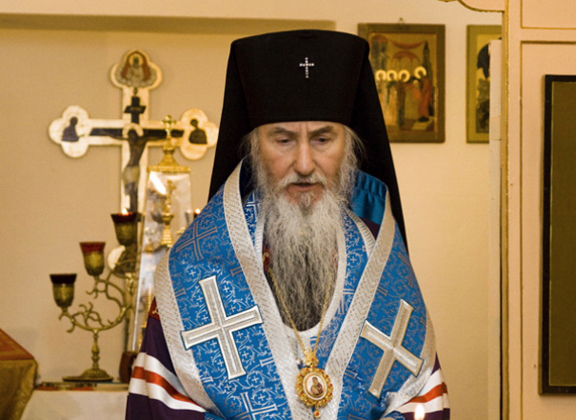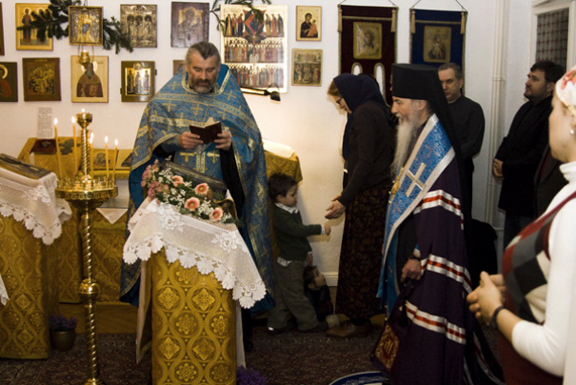
DIOCESE OF BERLIN AND GERMANY: January 24, 2008
A New Russian Orthodox Church to Be Built in the German Capital
For the first time in over 70 years, the Russian Orthodox Church Outside of Russia is planning to build a new church and parish center in Berlin. With this goal in mind, a parcel of land with a building was purchased from the real-estate concern Liegenschaftsfonds Berlin, right on the banks of the River Spree, a few minutes by foot from the City Hall of Charlottenburg, on Wintersteinstrasse.
 |
On January 16, 2008, the documents on the purchase are signed (from left to right: Warden of the community Igor Metzger; Rector of the Church of the Protection of the Most-Holy Mother of God, His Eminence Archbishop Mark of Berlin and Germany; Priest Andrej Sikojev; a notary public and representatives of Liegenschaftsfonds Berlin) |
After reconstruction, the Church of the Protection will be housed in the building. In the post-war years, this eldest of Orthodox communities of Berlin found a home on the first floor of an apartment building on Kulmbacherstrasse, in the Wilmersdorff area. This house-church has long ago become too small to accommodate the growing parish.
 "War and the post-war exile inflicted great wounds to the Russian community of Berlin, wounds that have finally healed. The new Russian Orthodox church in Berlin must be a place of prayer and parish life, and also a place for Russian art and culture, education, a place of hospitality and open meetings," said Archbishop Mark of Berlin and Germany. "I am happy that after many decades of searching, we found a new home in an area with such rich traditions, especially for the Russian emigration, as Charlottenburg." "War and the post-war exile inflicted great wounds to the Russian community of Berlin, wounds that have finally healed. The new Russian Orthodox church in Berlin must be a place of prayer and parish life, and also a place for Russian art and culture, education, a place of hospitality and open meetings," said Archbishop Mark of Berlin and Germany. "I am happy that after many decades of searching, we found a new home in an area with such rich traditions, especially for the Russian emigration, as Charlottenburg."
 Upon his arrival in Berlin, Archbishop Mark visited the house parish on Kulmbacherstrasse. Molebens to the Most-Holy Mother of God and St Seraphim of Sarov were served in gratitude for obtaining their new temple. Afterwards, a trapeza was held, during which the Archbishop spoke with the parishioners. Upon his arrival in Berlin, Archbishop Mark visited the house parish on Kulmbacherstrasse. Molebens to the Most-Holy Mother of God and St Seraphim of Sarov were served in gratitude for obtaining their new temple. Afterwards, a trapeza was held, during which the Archbishop spoke with the parishioners.
The following day, after the signing of the papers at the notary's office, Archbishop Mark examined the newly-purchased property and served a moleben and akathist to the Most-Holy Mother of God. He was joined by Fr Andrej Sikojev of the Protection Community.
"Our community reflects the multi-national character of Berlin. Our parishioners are Orthodox Christians with the broadest scope of national and cultural backgrounds. Along with the many emigres from Russia, Siberia and Ukraine, there are Orthodox Christians from France, Germany, Georgia, Belarus and Israel," said Fr Andrej, who himself was born in Moscow but grew up in Berlin. Our common language is Russian, followed by German. Our liturgical language, which most understand, is Church Slavonic. Some portions of our Liturgy, the Epistles and Gospel, are regularly read in German. The sermon is almost always translated concurrently into German."
After the reconstruction and renovation of the acquired building, which will have an area of 150 square meters, including the altar and narthex, while the vestry will be on the second floor. The first floor will have a parish hall, library and reading room, a rectory, a children's room and kitchen.
Alongside his clerical service, Fr Andrej recognizes the need for Orthodox youth ministry. The community planns a Russian Orthodox Art and Cultural Center. The next phase will be the construction of a bell tower. Also envisioned is the creation of a program to help the elderly and needy.
ADDITIONAL INFORMATION
The Russian Orthodox Church Outside of Russia (ROCOR) has dioceses in Europe, the US, Canada, Latin America and Australia. The Church is led by a Council of Bishops and a Synod of Bishops, located in New York City. The Primate is His Eminence Metropolitan Laurus of Eastern America and New York. Following the reunification of the Russian Orthodox Church (Moscow Patriarchate), the ROCOR remains an autonomous part of the All-Russian Council of Bishops. Its head is His Holiness Patriarch Alexy II.
The largest European diocese of ROCOR is the Diocese of Berlin and Germany, which includes communities in Germany, Great Britain, Denmark and Austria and is headed by Archbishop Mark. The see is located in Munich. The diocese was founded in the 18th century and is the oldest Orthodox diocese in Germany.
Among the three million Russian-speaking citizens of Germany, approximately 30% are Orthodox Christians, according to estimates from the two dioceses. In contrast to the Protestant and Catholic churches, the number of Orthodox parishes is growing. The number of parishioners is also growing.
Almost 200,000 Russian-speaking citizens live in Berlin. The majority of them emigrated from the former Soviet Union in the early 1990's. Another portion are descendants of the “old emigration“ who settled in Germany after the revolution and World Wars, and also Jewish emigres. At the present time, there are four Russian Orthodox churches in Berlin: the Cathedral in Hohenzollerndamm; the Church of SS Konstantin and Helen in Tegel; the house church in Karlshorst; and the house church of the Protection of the Most-Holy Mother of God in Kulmbacherstrasse (soon, the church on Wintersteinstrasse). The first three are churches of the Moscow Patriarchate under Archbishop Feofan, the other in the jurisdiction of ROCOR under Archbishop Mark.
Thanks to the initiative of Fr Andrej, Protection Parish over recent years actively helps the children of Beslan, who in 2004 became the victims of a terrorist act. The children are treated in Berlin clinics, and their parents are given spiritual and moral support and care.
On November 6, 2007, the Russian Orthodox Church opened a rehabilitation center in North Ossetia for the children of Beslan: Bishop Feofan of Stavropol and Vladikavkaz and Archbishop Mark of Berlin and Germany consecrated the center, built in Alansk Epiphany Convent (Alagirsk region of the Republic of North Ossetia-Alania), for the children who suffered at the hands of the terrorists.
© 2008, ROCA
“Protection of the Most-Holy Mother of God”
Kulmbacherstr. 6
10777 Berlin
DEUTSCHLAND

|